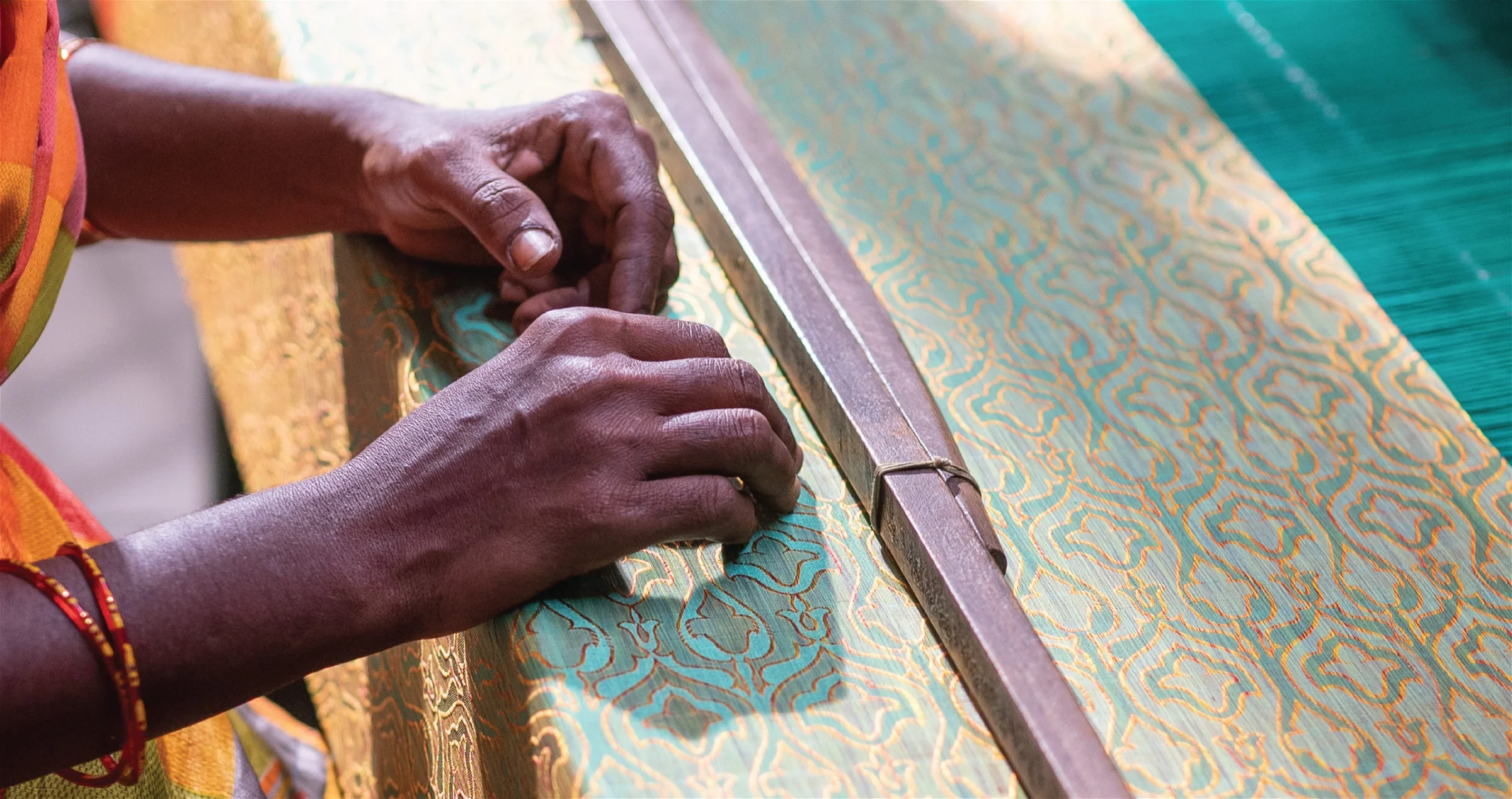The weaver who crafts a handwoven Kanchipuram silk saree is just one of many highly-skilled artisans who contribute to its making. This National Handloom Day, we featured the processes involved in the creation of a handwoven Kanchipuram silk saree, paying tribute to the skill and dedication of the people who ensure its perfection.
The weaving of silk sarees has shaped the town of Arani,75kms from Kanchipuram in Tamil Nadu. A sizable part of the population is involved in weaving and related crafts. It’s here, at the RmKV facility, that our silk sarees are handcrafted by a team of artisans who prepare the silk yarns, build the loom and its many components, weave the sarees and certify that they’re of the finest quality.

On 7th August every year, National Handloom Day celebrates the weavers who handcraft fabrics on the loom. Yet, there are several ancillary functions that support the weavers’ work, and over the many years that we’ve worked with them, our admiration for these craftspeople has only grown. Here’s a look at just a few of the many people and processes that make our handwoven Kanchipuram silk sarees so inimitable.
Twisting :
Every day, Munivel carefully weighs the finest silk yarns at the RmKV facility at Arani and decides whether they should become the warp or the weft yarn. He can do this just by touching the yarns, his instincts finely-tuned with over 30 years of experience.
At the Twisting facility, Munivel and his team clean and then ‘twist’ the yarns into one, two or three-ply silk threads. This ensures that the silk yarns are soft yet strong, paving the way for the weaver to create a Kanchipuram silk saree that will last generations.
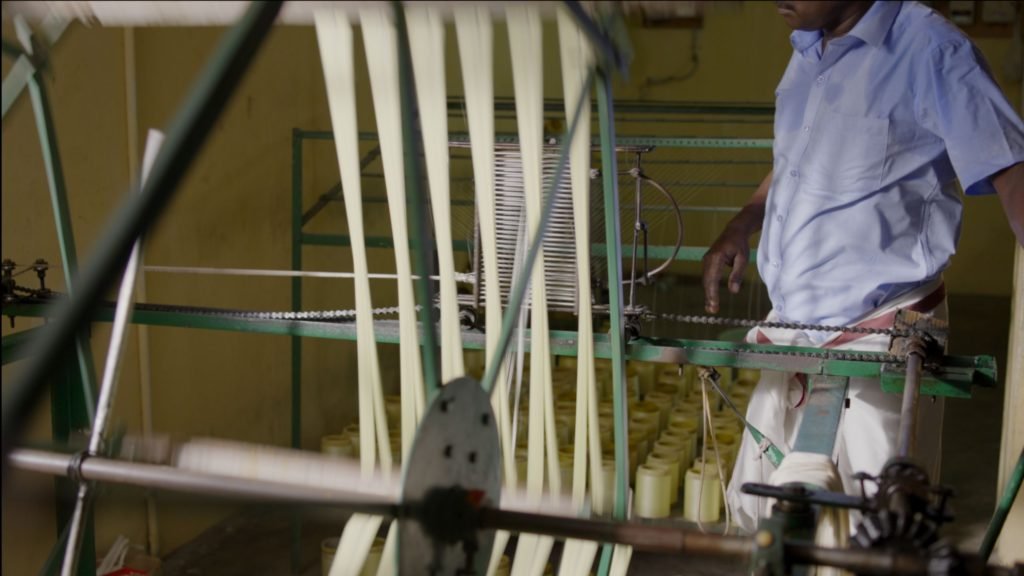
Scientific Dyeing :
Twisting is just one of the preparatory processes that silk yarns undergo before the weaver even begins his work. After passing inspection by Munivel, the selected yarns are brought to Kallapiran at RmKV’s Scientific Dyeing facility.
Kallapiran has been working with RmKV for 20 years. As the dyeing master at our facility, he oversees a series of processes, whether it’s degumming the twisted silk yarns to remove sericin Protein or maintaining detailed dyeing recipes for each of the 50,000 colours used in RmKV’s handwoven sarees. He’s also in charge of creating new colours with our R&D team.
While the yarns are being dyed, Kallapiran looks out for two things. First, the colour should be consistent throughout the yarn. Second, the dyeing process shouldn’t affect the strength of the silk fibres.
Scientific dyeing is a highly controlled process. First, the parts per million (PPM) of dye in the water is checked; then, the yarns are immersed in the dyeing vats, with the water at room temperature. The water temperature is gradually increased, so that the colour can seep into each fibre’s core. Each step in the dyeing process is recorded so that the exact formulae can be referenced and reproduced even years later. Yet, the real assurance of quality is the team’s dedication and time-honed intuition.

Sizing :
After they’re dyed, the silk yarns are distributed to weavers and their families for a process called sizing. The yarns measure 30 metres, and so the entire neighbourhood participates in the sizing process.
In a job that involves at least eight people, the yarns are untangled and stretched on poles across the street. Sizing alings the threads perfectly, making the eventual weaving process seamless. This also makes the fibres smoother, enhancing the suppleness of the saree.
Meanwhile, the weft is prepared by a process called pirn winding; here, the silk threads are tightly wound around bobbins that will be inserted into the shuttle at the time of weaving. It’s a task that the women at Arani’s villages are adept at. Then, it’s time for the warp to be meticulously fixed on the handloom. A warp thread can occasionally snap once it’s attached to the loom; fixing it requires finesse and is done through a process called ‘warp mending’.
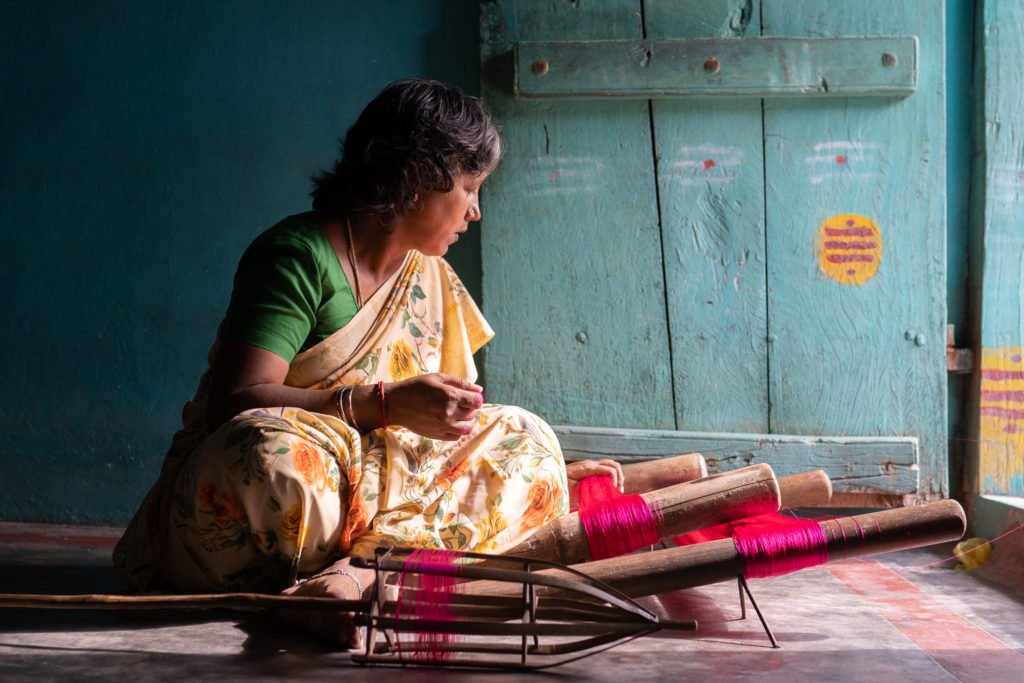
Handloom weaving is often done in craft clusters like Arani and its neighbouring villages. Watching the members of the weaving community coming together for a labour-intensive process like sizing makes one aware of how many people are involved in the creation of a single handloom silk saree. And, leaves us with a deeper appreciation for the craft and craftspeople.
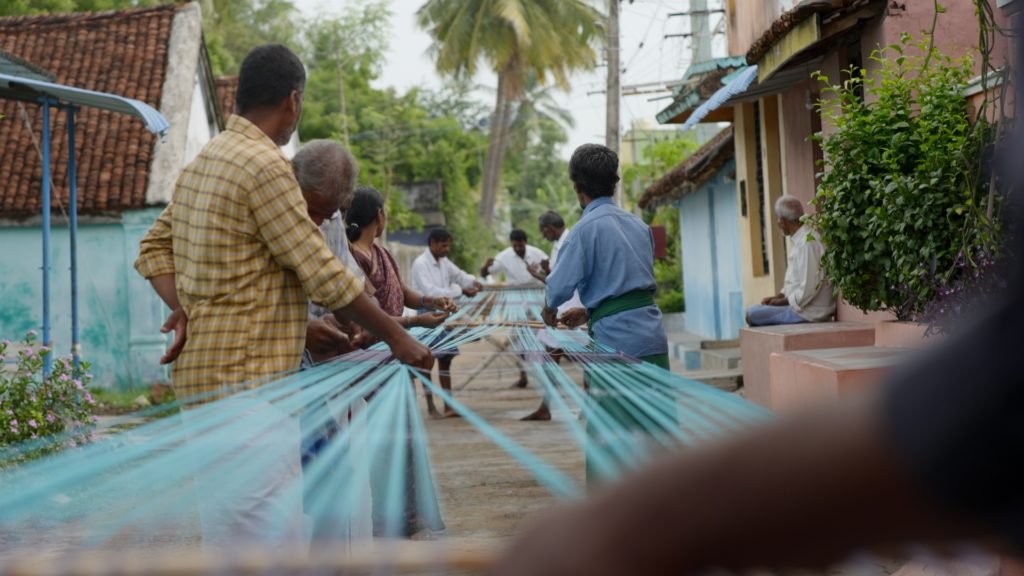
The loom :
The build of the loom determines the quality of the silk saree. One key component of the loom is the reed; think of it as a fine-toothed comb that separates the hundreds of warp threads on the handloom, enabling the weaver to smoothly intertwine the warp and weft threads and create the saree.
All the handlooms at our facilities in Arani are fitted with a bamboo reed. Daulat has been crafting reeds for us for 25 years; these reeds maintain the lustre of the zari and the smoothness of our handwoven Kanchipuram silk sarees.

Before the introduction of the jacquard loom, Kanchipuram silk sarees were handwoven on the adai (jala) loom. Here, the design of the saree was represented in loops and knots (the jala) and attached to the loom to lift the warp threads so that the weft patterns could be created. It was a complex loom that required tremendous effort and skill, and was eventually replaced by the simpler jacquard loom.
The jacquard loom stores different aspects of the saree’s design in jacquard cards and simplifies the weaving process. Yet, weaving still has its challenges. Pressing the pedals of the handloom involves lifting weights of up to 50kgs for each movement of the shuttle. The strain involved often discourages women from taking up weaving, and even younger generations prefer jobs that are physically less demanding.
RmKV’s patented invention, the Modern Pneumatic Handloom or MPHL, helps resolve this. Using compressed air to lift the jacquard cards, the MPHL lessens the physical strain of weaving. Moreover, its electronic jacquard controller stores hundreds of pre-loaded patterns, encouraging more creativity in the designs and greater customisation. With the MPHL,
weavers who were limited to creating three sarees a month can now weave up to 10!
Designing :
It’s not just the loom that has been modernised at RmKV. With the advent of CAD (Computer-aided Design), Jesvin, who is a part of our design team, creates the patterns that will be punched into jacquard cards for the loom. He draws each section in the binary language of 0s and 1s, and black and white. His designs are then passed on to artisans who replicate the patterns on the cards.
Each card contains a portion of the saree’s design, and has to be individually created by the craftsperson. Earlier, the designs were painstakingly hand drawn on graphs. A single misplaced pixel could ruin the design of the saree. While this method suited smaller designs, manual graph designs were limited in scale.
With CAD, the canvas has expanded vastly, while still allowing for fine detailing. Even a saree that’s 50″ in width and 216″ in length with no pattern repetitions can be digitally designed. Jesvin and our team of designers have converted the designs of even our most complex innovations like the Hamsa Damayanti saree, the Varna Jalam saree, 108 Karnas and many more into digital renditions. Sarees can even be customised, their design fine-tuned to the smallest detail according to the customer’s specifications.
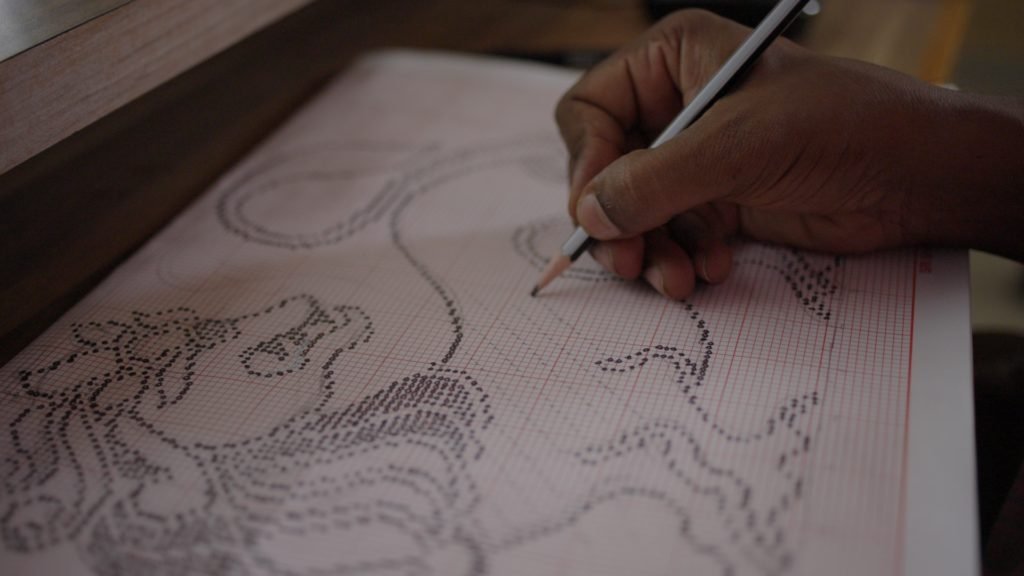
Weaving :
Now, with the warp stretched tight and the jacquard cards lined up, Kumar – our master weaver – takes his seat at the handloom. Alongside dozens of exceptionally talented weavers, Kumar has woven some of our most iconic creations – the National Award-winning Hamsa Damayanti saree, the 50,000 colour saree, and the Grand Reversible saree, to name a few.
With practised eyes and deft hands, our weavers combine the results of all the ancillary crafts – twisting, dyeing, sizing – into a seamless symmetry. Kanchipuram is particularly famous for the pettni or korvai technique of weaving the border and pallu of the saree separately and then interlocking them with the body. This brings a high contrast to the saree and requires immense skill.
While handweaving a Kanchipuram silk saree, the weaver is required to be well-versed in the certain ancillary techniques as well. For example, if a thread snaps while weaving, he or she must be able to mend it seamlessly. Misplaced threads have to be immediately spotted and corrected to ensure that the design is symmetrical and the colours are consistent. The speed and precision with which our weavers do this make the process look effortless; in fact, it comes from decades of experience. Even so, weaving a Kanchipuram silk saree requires so much physical effort and concentration that even the most experienced weaver takes a week to craft a single Kanchipuram bridal silk saree.
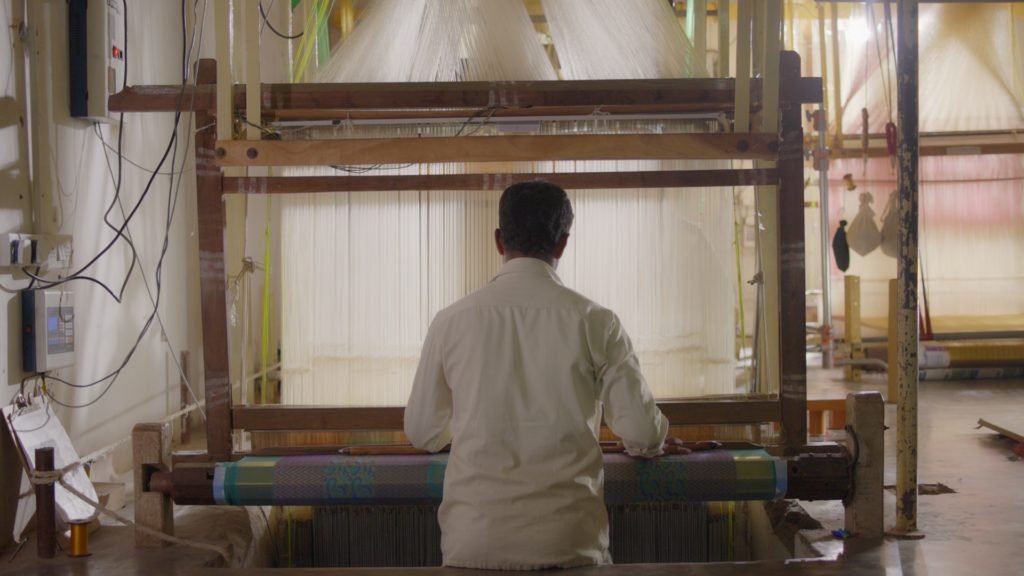
Quality control :
Even after the care and skill poured into the silk saree at every stage, it must go through quality checks at the RmKV offices in Arani. Ravi heads the quality control team and, under bright lights, they look over every section and motif of the saree.
Their checklist includes a sharp selvedge, a clear design and perfect finish. Extra threads are snipped, dimensions measured, and the texture tested by touch. If the saree doesn’t meet our criteria, it’s sent back. Many of our quality inspectors have been weavers themselves; Ravi worked at the handloom for 20 years. Decades spent behind the handloom have made them familiar with every kind of saree and design, and they bring crucial practical knowledge to the inspection process.

Once the saree is approved by Ravi and his team, it is folded into nine layers and deftly packed.
And then, it passes into the hands of someone who’s as important to the handloom industry as the artisans mentioned here – you. When you buy a handwoven silk saree, or any handmade product for that matter, you support the skills and livelihoods of dozens of artisans. Because, a handloom saree is far more than a tapestry of silk threads; it’s a collection of human experiences.
—————————-

